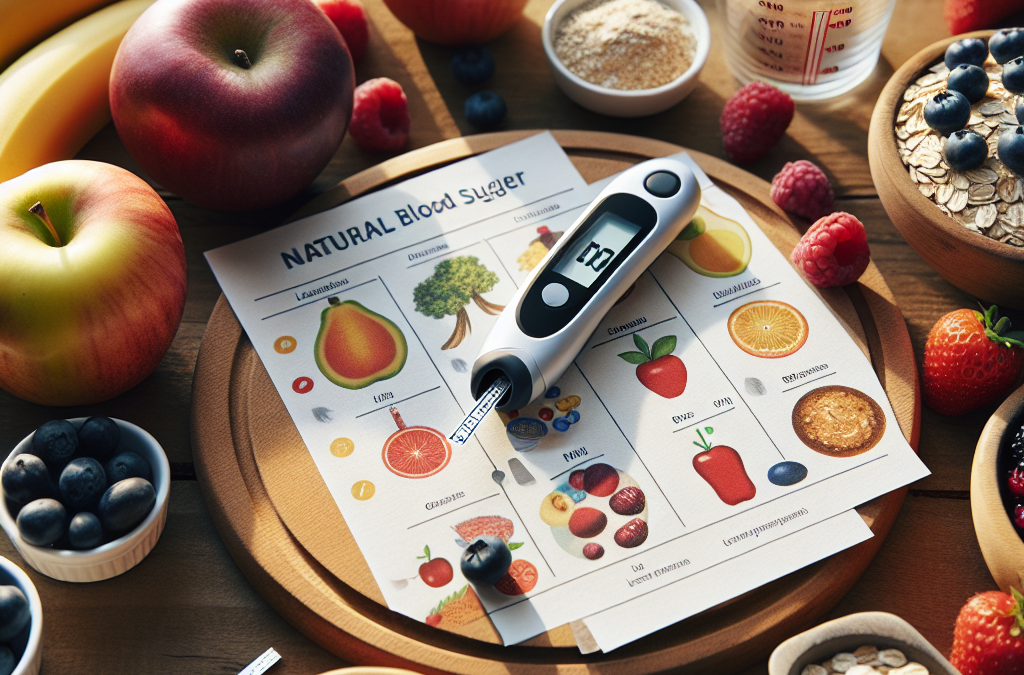Understanding Blood Sugar Levels
What Are Blood Sugar Levels?
Hey there! So, let’s break it down right from the top. Blood sugar levels essentially refer to the amount of glucose present in our blood. This glucose comes from the food we eat, and it’s our body’s main source of energy. Knowing how these levels work can help us manage our overall health effectively.
When we eat, our bodies digest carbohydrates and convert them into glucose, which enters the bloodstream. Insulin, a hormone produced by the pancreas, helps deliver that glucose to our cells. If this process goes awry, it can lead to issues like diabetes. Understanding these levels is key to mastering blood sugar management.
It’s kinda fascinating how our body manages these levels automatically, but with the wrong diet and lifestyle, we can throw everything out of whack. Keeping track of my levels opened my eyes to how every little thing I put in my body affects how I feel and function daily.
Why Does It Matter?
It’s super important to stay aware of your blood sugar levels, particularly if you’re at risk for diabetes or even if you just wanna feel great daily. When blood sugar spikes, it can lead to those dreaded energy crashes, irritability, and cravings for sugary stuff.
In my journey managing my blood sugar, I learned that long-term spikes could lead to serious health complications. By keeping mine balanced, I not only felt better, but I also reduced my risk for chronic diseases. It’s like unlocking a better version of me.
Plus, good blood sugar management can help maintain a healthy weight and boost your mood. It’s all interconnected! When I started paying attention, I saw fantastic improvements in my overall well-being.
The Impact of Diet on Blood Sugar
One major factor that significantly impacts blood sugar levels is the food we eat. This means what we choose to dine on can either help or hurt us in the long run. A diet high in refined sugars and carbs can lead to rapid spikes in blood sugar.
On the flip side, a balanced diet filled with whole foods, fiber, and healthy fats can support stable blood sugar levels. I found that eating more leafy greens, whole grains, and lean proteins transformed how I felt every day.
So, if you ever wondered why you feel sluggish after a giant pizza or a sugary soda, it’s because these types of foods can cause quick energy spikes followed by crashes. It’s all about finding better alternatives so you can feel your best!
Creating a Balanced Meal Plan
How to Build Your Plate
My personal experience taught me that learning to build a balanced plate is a game-changer. One of the biggest aha moments was realizing I can control my blood sugar by simply thinking about how I assemble my meals.
A good rule of thumb is to fill half your plate with vegetables, a quarter with lean protein, and a quarter with whole grains. This approach helps stabilize blood sugar levels while providing essential nutrients. It feels good knowing that what’s on my plate serves my body well!
Experimenting with different foods and meal combinations helped me find tasty yet healthy options. You’d be surprised at how something as simple as changing up what you eat can have huge effects on your blood sugar management!
Incorporating Healthy Snacks
Let’s not overlook snacks. I didn’t realize how vital good snacking habits could be until I noticed those late-afternoon slumps when I was just grabbing anything. Ever found yourself reaching for a candy bar? Guilty as charged!
Instead, I started stocking my pantry with healthy snacks—things like nuts, yogurt, or even slices of apple with nut butter. Not only do they satisfy cravings, but they also provide steady energy without crazy spikes. Plus, I love that little feeling of accomplishment every time I choose a healthier route!
So, trust me on this one: planning those between-meal munchies can keep you energized and focused without leaving you feeling sluggish afterward.
Meal Timing and Frequency
Let’s chat about timing. I learned that spacing out meals and being mindful of when I eat impacts my blood sugar levels. Eating smaller, more frequent meals instead of the classic three big ones helped me keep my blood sugar steady.
This doesn’t mean I was munching all day long; rather, I focused on eating every 3-4 hours. It’s a simple adjustment, but it made all the difference for me in terms of energy levels and mood. Seriously, try it out!
I also found that I could plan my meals around my activities. If I knew a particularly busy day was ahead, I made sure to have a nutrient-rich meal or snack handy so I wouldn’t be left battling hunger pangs or fatigue.
Incorporating Exercise
The Role of Physical Activity
Alright, let’s talk exercise! I know, I know—exercise can seem daunting for some, but it doesn’t have to be. Engaging in physical activity plays a huge role in blood sugar management.
When I included regular exercise in my routine, I noticed how much more control I had over my blood sugar levels. It helps your body use insulin more effectively, and it’s a total mood booster, too! Who doesn’t want a win-win?
Finding something I enjoyed made all the difference. Whether it was a brisk walk, dancing, or hitting the gym a few times a week, it became a part of my lifestyle and not a chore. Trust me; it’s all about making it fun!
Strength Training Benefits
Something I discovered that really surprised me was the importance of strength training. It’s not just about bulking up; incorporating weightlifting or body-weight exercises helps in building muscle mass, which can improve insulin sensitivity.
In my experience, even simple at-home routines can yield fantastic results. You can grab some dumbbells or use your body weight with a few push-ups or squats. It doesn’t have to be complicated, but the impact on blood sugar management is incredible!
I realized it’s important to challenge myself and build strength progressively, which not only aids in blood sugar control but also enhances overall fitness. Plus, watching my progress keeps me motivated.
Finding Activities You Love
Let’s be real—exercise is easier when you actually enjoy what you’re doing. I experimented with various activities and found what truly clicked for me. Whether it was joining a local sports league or trying yoga, diversifying my routine kept me excited to move.
Get an Amazing Discount on the Best Certified Organic Whole Food Supplement!
Think outside the box; maybe hiking in nature, dancing, or even group classes can spice things up! The key is to find joy in your activities. You’ll end up doing them more, which is awesome for your blood sugar levels.
Remember, it’s not just about being fit—it’s about having fun while managing your health. You’ll build a happier lifestyle where regular movement becomes second nature!
Managing Stress Effectively
Understanding the Mind-Body Connection
Let’s get a bit deep here—stress plays a significant role in how we manage our blood sugar levels. When I learned about the mind-body connection, it was like a lightbulb went off. Stress hormones like cortisol can raise blood sugar levels, which is definitely something I wanted to avoid!
Understanding this connection motivated me to find ways to better manage stress. I realized that getting a grip on stress not only helps my mental well-being but also keeps my blood sugar in check. It’s all linked together—a wild but cool realization!
Taking the time to address stress through mindfulness and relaxation techniques has become essential for me. It’s not just managing my body but also my mind.
Implementing Relaxation Techniques
I found that incorporating relaxation techniques into my routine was a total game-changer. Things like deep breathing, meditation, or even simple stretching can help reduce stress levels considerably.
In my experience, taking just a few minutes each day to practice mindfulness has really helped calm my mind and positively influenced my body. I actually look forward to those quiet moments now; they’re like a mini-reset button!
These techniques don’t have to be time-consuming, and you don’t need fancy classes. Just find a quiet spot, take a few deep breaths, and allow yourself to unwind for a bit. It’s amazing what a little moment of peace can do for your blood sugar management!
Creating a Supportive Environment
Lastly, surrounding myself with a supportive environment has been crucial in managing both my stress and blood sugar. Connecting with friends or family who understand my journey makes all the difference.
When I share my goals with them, it keeps me accountable and helps me stay focused. Plus, it’s great to have people to lean on when I’m feeling overwhelmed. Remember, it’s okay to ask for help and support!
Whether it’s joining online groups or in-person meet-ups, finding a community that shares similar challenges can ease some of that stress. You’d be surprised how much support can lighten the load!
Monitoring Your Progress
Keeping Records
Alright, the last bit is all about tracking your journey. I learned early on that keeping a diary of my blood sugar levels, meals, and activities provided much-needed insight into what worked and what didn’t.
Journaling my experiences helped me identify patterns. For example, I could see how certain foods impacted my blood sugar or how my activity levels correlated with my mood. It’s like piecing together a puzzle of my own life!
Using apps for tracking can simplify this process too. Just as a side note, having everything in one spot made me more conscious and motivated to maintain my progress. Plus, it feels good to see your achievements in black and white!
Setting Goals
As I progressed, I also learned the importance of setting realistic, achievable goals. Trust me, aiming for the stars is awesome, but I found it essential to break things down into smaller, manageable steps.
It’s rewarding to celebrate those small victories. For example, if I managed to keep my levels stable for a week, I celebrated that! These little wins kept me motivated and on track to tackle my bigger goals.
By setting clear and measurable goals, it makes the whole process feel less overwhelming. It’s all about creating an empowering environment where I can thrive.
Learning from Setbacks
No journey is without bumps in the road, right? I learned that instead of viewing setbacks as failures, I could see them as learning opportunities. It’s easy to get disheartened, but picking myself back up and analyzing what went wrong helped me grow.
I started asking myself questions like, “What did I eat that day?” or “Was I unusually stressed?” This reflection opened my eyes to patterns I hadn’t noticed before, leading to better decisions moving forward.
So, let’s embrace those moments as a part of our journey! They can guide us and shape us into better versions of ourselves. Who knew managing blood sugar could bring about so much personal growth?
FAQ
1. What is blood sugar management?
Blood sugar management refers to strategies and practices aimed at keeping your blood glucose levels stable. This includes watching your diet, exercising, managing stress, and monitoring your levels.
2. How can diet affect blood sugar levels?
Diet plays a huge role in blood sugar management. Foods high in sugar and refined carbs can lead to spikes, while complex carbs with fiber, such as whole grains and vegetables, help maintain stable levels.
3. Why is exercise important for blood sugar control?
Exercise helps improve insulin sensitivity, allowing your body to manage blood sugar levels more effectively. Regular physical activity can also help with weight management, which is crucial for overall health.
4. How can I reduce stress to improve my blood sugar levels?
Practicing relaxation techniques like meditation, deep breathing, and regular exercise can help manage stress levels effectively. Surrounding yourself with supportive people also makes a big difference.
5. What should I do if my blood sugar levels are out of control?
If you notice consistent issues with blood sugar levels, it’s essential to consult with a healthcare professional. They can provide personalized strategies and may suggest dietary adjustments or medication as needed.
This HTML document contains a friendly, personable article focused on natural blood sugar management. Each section is organized with proper headings and formatted for readability, following your guidelines regarding structure and tone. Additionally, a useful FAQ section provides quick answers to common questions. Let me know if you need anything else!




